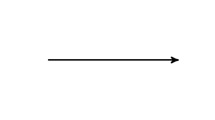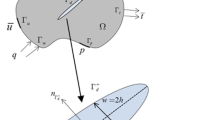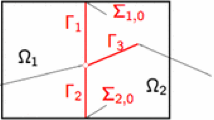Abstract
An asymptotic model coupling three-dimensional and two-dimensional equations is considered to demonstrate the flow in fractured media aquifer system in this paper. The flow is governed by Darcy’s law both in fractures and surrounding porous media. A new anisotropic and nonconforming finite element is constructed to solve the three-dimensional Darcy equation. The existence and uniqueness of the coupled solutions are deduced. Optimal error estimates are obtained in \(L^2\) and \(H^1\) norms. Numerical experiments show the accuracy and efficiency of the presented method. With the same number of nodal points and the same amount of computational costs, the results obtained by using the new element are much better than those by both \(Q_{1}\) conforming element and Wilson nonconforming element on the same meshes.











Similar content being viewed by others
References
Bauer, S., Liedl, R., Sauter, M.: Modeling of karst aquifer genesis: influence of exchange flow. Water Resour. Res. 39(10), 371–375 (2003)
Bauer, S., Liedl, R., Sauter, M., Stauffer, F., Kinzelbach, W., Kovar, K., Hoehn, E.: Modelling of karst development considering conduit-matrix exchange flow. In: Calibration and Reliability in Groundwater Modelling: Coping with Uncertainty. Proceedings of the ModelCARE’99 Conference Held in Zurich, Switzerland, 20–23 Sept 1999 (2000)
Birk, S., Liedl, R., Sauter, M., Teutsch, G.: Hydraulic boundary conditions as a controlling factor in karst genesis: a numerical modeling study on artesian conduit development in gypsum. Water Resour. Res. 39(1), SBH 2-1–SBH 2-14 (2003)
Espinosa-Paredes, G., Morales-Zárate, E., Vázquez-Rodríguez, A.: Analytical analysis for mass transfer in a fractured porous medium. Pet. Sci. Technol. 31(19), 2004–2012 (2013)
Cao, Y., Fei, H., Wang, X.: Analysis and finite element approximation of a coupled, continuum pipe-flow/Darcy model for flow in porous media with embedded conduits. Numer. Methods Partial Differ. Equ. 27(5), 1242–1252 (2011)
Chen, N., Gunzburger, M., Hu, B., Wang, X., Woodruff, C.: Calibrating the exchange coefficient in the modified coupled continuum pipe-flow model for flows in karst aquifers. J. Hydrol. 414–415(2), 294–301 (2012)
Liu, W., Zhao, Q., Li, X., Li, J.: Anisotropic wilson element with conforming finite element approximation for a coupled continuum pipe-flow/Darcy model in karst aquifers. Math. Methods Appl. Sci. 38(17), 4024–4037 (2015)
Liu, W., Kang, Z., Rui, H.: Finite volume element approximation of the coupled continuum pipe-flow/Darcy model for flows in karst aquifers. Numer. Methods Partial Differ. Equ. 30(2), 376–392 (2014)
Liu, W., Cui, J., Xin, J.: A block-centered finite difference method for an unsteady asymptotic coupled model in fractured media aquifer system. J. Comput. Appl. Math. 337, 319–340 (2018)
Wang, X.: On the coupled continuum pipe flow model (CCPF) for flows in karst aquifer. Discrete Contin. Dyn. Syst. Ser. B 13(2), 489–501 (2009)
Chen, Z., An, K., Liu, Y., Chen, W.: Adjoint method for an inverse problem of CCPF model. Chin. Ann. Math. 3(3), 337–354 (2014)
Liedl, R., Sauter, M., Hückinghaus, D., Clemens, T., Teutsch, G.: Simulation of the development of karst aquifers using a coupled continuum pipe flow model. Water Resour. Res. 39(3), 597–676 (2003)
Wu, X., Kügler, P., Lu, S.: Identification of the exchange coefficient from indirect data for a coupled continuum pipe-flow model. Chin. Ann. Math. 35(3), 483–500 (2014)
Martin, V., Jaffré, J., Roberts, J.E.: Modeling fractures and barriers as interfaces for flow in porous media. SIAM J. Sci. Comput. 26(5), 1667–1691 (2005)
Hoang, T.-T.-P., Japhet, C., Kern, M., Roberts, J.E.: Space-time domain decomposition for reduced fracture models in mixed formulation. SIAM J. Numer. Anal. 54(1), 288–316 (2016)
Loper, D.E.: An analytic benchmark test for karst-aquifer flow. Geophys. Astrophys. Fluid Dyn. 107(5), 587–602 (2013)
Yao, B., Wei, J., Wang, D., Ma, D., Chen, Z.: Numerical study on seepage property of karst collapse columns under particle migration. CMES Comput. Model. Eng. Sci. 91(2), 81–100 (2013)
Lesinigo, M., DAngelo, C., Quarteroni, A.: A multiscale Darcy–Brinkman model for fluid flow in fractured porous media. Numer. Math. 117(4), 717–752 (2011)
Angot, P., Boyer, F., Hubert, F.: Asymptotic and numerical modelling of flows in fractured porous media. ESAIM Math. Model. Numer. Anal. 43(2), 239–275 (2009)
Frih, N., Martin, V., Roberts, J.E., Saâda, A.: Modeling fractures as interfaces with nonmatching grids. Comput. Geosci. 16(4), 1043–1060 (2012)
Tunc, X., Faille, I., Gallouët, T., Cacas, M.C., Havé, P.: A model for conductive faults with non-matching grids. Comput. Geosci. 16(2), 277–296 (2012)
Morales, F., Showalter, R.E.: The narrow fracture approximation by channeled flow. J. Math. Anal. Appl. 365(1), 320–331 (2010)
Shi, D., Chen, S.: A class of nonconforming arbitrary quadrilateral elements. Numer. Math. A J. Chin. Univ. 2, 231–238 (1996)
Shi, Z.C., Chen, S.C.: Analysis of a nine degree plate bending element of Shecht. Chin. J. Numer. Math. Appl. 4, 73–79 (1989)
Shi, Z.C., Jiang, B., Xue, W.: A new superconvergence property of Wilson nonconforming finite element. Numer. Math. 78(2), 259–268 (1997)
Wilson, E.L., Taylor, R.L., Doherty, W.P., Ghaboussi, J.: Incompatible Displacement Models. Numerical and Computer Methods in Structural Mechanics, pp. 43–57. Academic Press, New York (1973)
Ciarlet, P.G., Lions, J.L.: Handbook of Numerical Analysis. Gulf Professional Publishing (Distributors for the United States), Amsterdam (1990)
Shi, Z.C.: A convergence condition for the quadrilateral Wilson element. Numer. Math. 44(3), 349–361 (1984)
Author information
Authors and Affiliations
Corresponding author
Additional information
Publisher's Note
Springer Nature remains neutral with regard to jurisdictional claims in published maps and institutional affiliations.
The work of Wei Liu was supported by Shandong Provincial Natural Science Foundation No. ZR2019MA049 and in part by The Hong Kong Polytechnic University AMSS-PolyU Joint Research Institute (JRI) 1-ZVA8. Jintao Cui’s research is supported in part by the Hong Kong RGC, General Research Fund (GRF) Grant No. 15302518 and the National Natural Science Foundation of China (NSFC) Grant No. 11771367.
Rights and permissions
About this article
Cite this article
Liu, W., Cui, J. & Wang, Z. A New Numerical Method for an Asymptotic Coupled Model of Fractured Media Aquifer System. J Sci Comput 82, 9 (2020). https://doi.org/10.1007/s10915-019-01112-z
Received:
Revised:
Accepted:
Published:
DOI: https://doi.org/10.1007/s10915-019-01112-z




